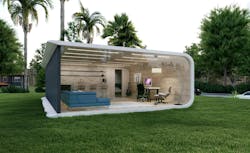3D Printing, Prefab, Modular—A Startup Delivers All Three in One
Not content with just one construction innovation, Azure Printed Homes combines a trio of leading-edge methods: 3D printing, prefab, and modular. “We see it as a new category of construction,” says Ross Maguire, CEO and cofounder, Azure. “With the global housing crisis and the climate crisis, there needs to be a big shift in how we produce homes.”
Azure could signal one such shift.
The LA-based company 3D prints modular units with about 70% of the printing material consisting of recycled plastic, while the remainder comprises fiberglass and other compounds. Of each unit’s six sides, Azure 3D prints four: the roof, the floor, and two of the walls—all in one day. Clients can customize the two remaining walls—opting for floor-to-ceiling windows, for instance—and can choose from several different options for the interior finishes, kitchens, and bathrooms.
Azure transports the fully finished modular unit to its foundation site and then installs it—again, in a single day. Connecting the module to utilities can take a couple of days for smaller units, four or five days for larger ones.
“When the units leave our facility, they’re ready to be plugged in and lived in,” Maguire says.
USING RECYCLED MATERIALS FOR 3D PRINTED UNITS
While other 3D-printing homebuilders use concrete for the printing material, Azure decided to go with a recycled product for its environmental benefit. In addition, by using a lighter, more flexible material instead of concrete, Azure avoids having to transport its 3D printer to each job site. Instead, the company 3D prints each home in its own 10,000-square-foot factory located in Culver City, Calif.
Also, the plastic polymers, commonly used in plastic bottles and food packaging, form a contained, waterproof structure. As a result, Azure doesn’t rely on trades to build roofs, since each Azure unit comes with its own built-in roof.
With years of experience in constructing and developing properties, Maguire and Gene Eidelman cofounded Azure in 2019, the year after Maguire left the U.K. for the U.S. “We wanted to come up with new, innovative ways to approach the industry,” Maguire recalls. “We’d both been in the industry for a while and shared similar frustrations with the fact that construction is one industry that has remained fairly untouched for many, many years.”
After starting off as a general contractor, Azure moved into pre-engineered, panelized construction. About a year and a half ago, Maguire decided to venture into 3D printing. “We’re still at the tip of the iceberg, but we’re excited by what we have and where we can take it.”
For now, Azure is focusing on single-story accessory dwelling units (ADUs)—ranging from a 180-square-foot studio ADU that starts at $39,900 to a 900-square-foot, two-bedroom, one-bathroom ADU that starts at $199,900. (The listed prices cover the completed modules, not the costs for the shipping, foundation, and utility connections.)
Thanks to its construction process, Azure builds ADUs 70 percent faster and 20 to 30 percent cheaper than similar, conventionally built ADUs, Maguire says.
RELATED: Robots and Prefabs and Printing, Oh My!
As of late August 2022, Azure had 88 orders for 111 units and was waiting for its 3D printer’s final parts. After that shipment arrives, the company anticipates starting its first production line a month or two later, Maguire says. Azure’s printer will produce one modular unit per day. With just 12 employees, Azure looks to double that number once its first production line begins.
“For now, everything [we build] is single-story compact homes that are suitable for highly populated areas,” Maguire says. Azure’s ADUs align with the growing interest in tiny homes and in living less cluttered lives, he adds.
But Azure also sees ADUs as “a stepping stone” to larger homes, Maguire says. “There’s no limit to how far this can go.” In the future, Azure could begin stacking its modular units vertically to create larger structures. “We want to get to a point where modular units can be added together to create custom homes, so it’s potentially a solution across all use cases.”
Eventually, the company plans to add two more 3D printers to its Culver City facility—and then open other factories in other locations. Maguire wants to ensure the first factory runs smoothly and efficiently before replicating it elsewhere.
Azure has been fielding interest from clients wanting ADUs, build-for-rent properties, and homes for the unhoused, among other project types. The company has received inquiries from people in Florida, Texas, and other states, as well as Asia, Australia, and Europe.
“We see [Azure’s process] as a big step forward to producing lots of affordable homes with a positive impact on the environment globally,” Maguire says.



